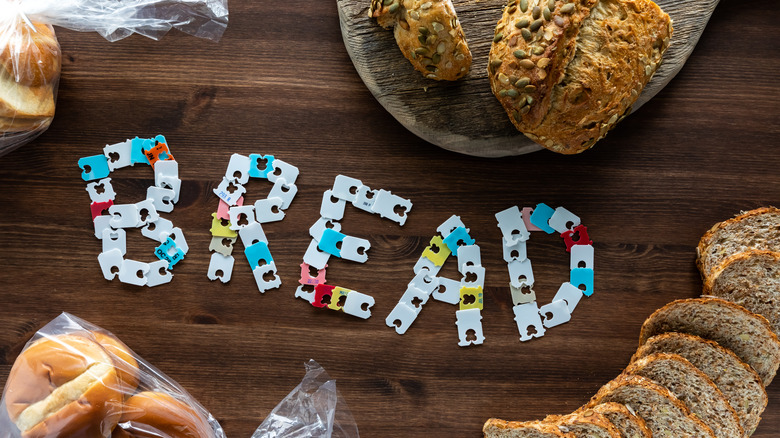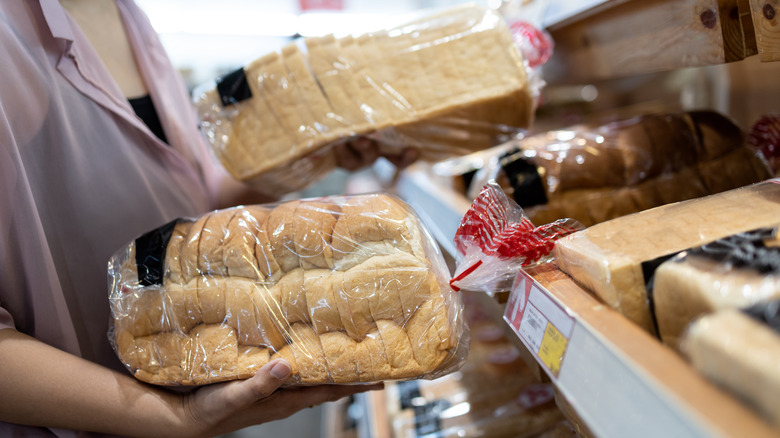The Plastic Tags On Your Bread Aren't Random Colors
If you've ever struggled to open a bag of bread, the skirmish can probably be blamed on the clip. Designed to be more helpful than harmful, the plastic U-shaped tags pinch open-ended bags shut, extending the freshness of loaves, bagels, rolls, or produce stored inside. In fact, when the piece of plastic hit the market in 1954, it was sold by Kwik Lok to safely secure bags of Washington apples, preventing the fruit from spoiling early or spilling out onto grocery store floors. The prototype of the tag was created two years earlier by manufacturing engineer Floyd Paxton, who wanted to save a packet of leftover airline peanuts for future snacking. According to The Oregonian, he carved the first plastic clip from a credit card, unwittingly changing the way the world packages bread.
While you likely don't spend much time thinking about bread bag clips beyond whether to throw them away, you may have noticed they come in different colors. The varied hues aren't random, though, nor are they for aesthetics. Turns out, the plastic tags are part of a color-coding system used by bakeries and grocery stores to keep tabs on when bread and other baked goods are made.
Each shade refers to a day of the week, which has led to some shoppers trying to use the information strategically to buy the freshest loaves possible. However, the system isn't universal across the bread packaging industry, so the code isn't easy to crack and use as a grocery shopping hack.
The color-coded system shows when bread was baked
Plastic bread clips and twist ties come in almost all colors of the rainbow (and then some). Bakeries and bread suppliers use these hues to mark the days on which loaves were packaged or sliced. The color-coded system can help effectively manage production and delivery schedules. Often paired with alphanumeric codes, the colors also allow bakeries to track specific batches of bread, especially useful for dealing with potential quality issues. The system comes in handy for grocery stores, too. By quickly scanning the colored tabs, employees restocking everything from bagels to buns can mark down goods that should be sold ASAP or snag old bread off the shelves altogether.
However, there isn't an industry-wide standard for color-coding bread tags. Not all bakeries and suppliers operate according to the same schedules, so there isn't a single system for all brands or baked goods – despite what speculation online suggests. As a result, there are plenty of potential codes, which can lead to confusion when scoping out the colored tabs and ties in the bread aisle of different stores. Fact-checking website Snopes outlined one of the most common color keys: Blue for Monday, green for Tuesday, red for Thursday, white for Friday, and yellow for Saturday, skipping Wednesday and Sunday as no-delivery days. Of course, bread tags sometimes come in pink or orange, and some bakeries may operate on a different schedule. Memorizing the secret meanings behind the colors seems fruitless, after all.
Trying to crack the bread clip color code isn't useful for shoppers
When you choose a loaf of bread, supermarkets are already a step ahead of you. Not only are store employees already carefully managing inventory, often aided by their insider knowledge of specific color-coded systems, but bread doesn't tend to stay on the shelves long enough for freshness to be an issue. Between restocking and customer demand, most loaves only spend a couple of days sitting around before being removed or bought.
Store-bought bread also stays fresh for a while depending on how you store it. Commercially baked bread can safely sit out at room temperature for two to four days. While the fridge should be the last resort for bread storage, a loaf will stay fresh for one to two weeks. For long-term storage, turn to the freezer, where bread can be kept for up to three months.
If you're really serious about buying the freshest bread, though, check the bag tag for a "use-by" or "sell-by" date. Figuring out what exactly the expiration date means on food packaging can also be a bit complicated, but it's the easiest way to ensure you head home with the best bread for your needs. And if you do want to know what the colored clips mean for your specific loaf, all you need to do is ask a store employee or contact the bread supplier directly. Chances are, they'll let you in on the secret.


